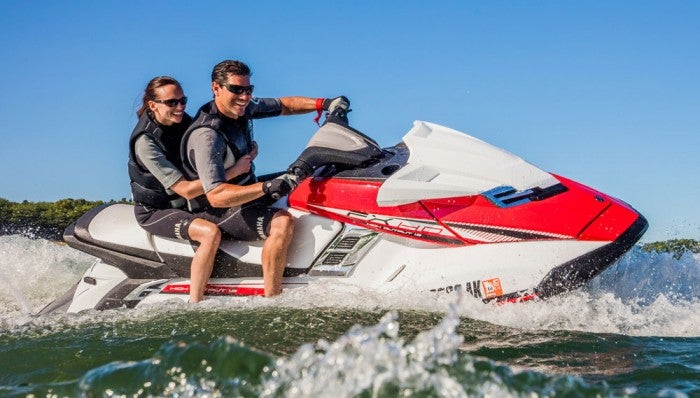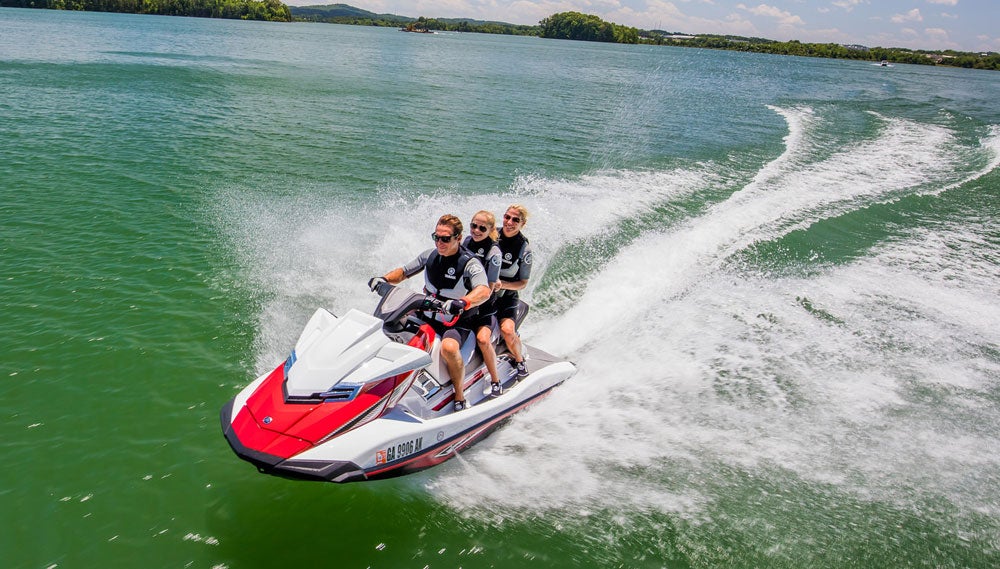2017 Yamaha FX HO Review
The most affordable option in the flagship FX family
There’s a real estate strategy that says you should buy one of the least expensive homes in a more expensive neighborhood. Transfer the same strategy to the personal watercraft market and a craft like Yamaha’s FX HO makes perfect sense.
Engine: Four-cylinder 1,812cc
Fuel Capacity: 18.5 gal.
Stowage Capacity: 33.2 gal.
Seating Capacity: 3
MSRP: $13,199
From a big-picture viewpoint, to FX HO is part of Yamaha’s flagship FX line, a series that has excelled in rough and calm water conditions, satisfied both performance and cruiser audiences, and showcased a wealth of the industry’s most luxurious and sought-after features. Without a supercharger, however, it’s like that less-expensive house on the block. It’s less expensive to purchase upfront, and less thirsty for fuel down the road, significantly stretching your gas budget.
It’s a practical choice…but one that includes nearly all the benefits of the FX neighborhood in which it resides.
Special FX
 The FX platform may be quite familiar, but it’s far from getting long-in-the-tooth. The 140” long, deep-V hull design continues to excel in both calm and challenging conditions, carving up a precision turn in the former and carrying passengers through the latter with Yamaha’s trademark stability and legendary big-water prowess. Fine tune both through the use of electric trim, dropping the bow to place more hull in the water during turns or raising it to lessen wetted surface in high-speed runs. The quick reaction time of the electric trim (and placement of the trim controls adjacent to the left handle grip) allows you to change things up on the fly for ultimate performance, and puts to rest lingering memories of the manual trim Yamaha embraced for too long.
The FX platform may be quite familiar, but it’s far from getting long-in-the-tooth. The 140” long, deep-V hull design continues to excel in both calm and challenging conditions, carving up a precision turn in the former and carrying passengers through the latter with Yamaha’s trademark stability and legendary big-water prowess. Fine tune both through the use of electric trim, dropping the bow to place more hull in the water during turns or raising it to lessen wetted surface in high-speed runs. The quick reaction time of the electric trim (and placement of the trim controls adjacent to the left handle grip) allows you to change things up on the fly for ultimate performance, and puts to rest lingering memories of the manual trim Yamaha embraced for too long.
The deck above is decidedly masculine in appearance, particularly in the angular front section which incorporates a pair of rearview mirrors into the hatch for the bow storage. This familiar shape is freshened up for ’17 with a brilliant Pure White paint job with accent touches of Torch Red Metallic that make the boat both highly visible on the water and truly pop on the beach. Driver and passengers enjoy a sloped saddle with minimal bolsters. You may miss them on an extended ride, but the sleeker profile will prove better for riders that like to shift their weight in the saddle as well as passengers of multiple body sizes, not to mention a rear-facing spotter during watersports. The driver enjoys pistol-style grips and conveniently placed buttons to control the information display’s various modes. Grippy, two-tone traction is found underfoot for all.
Storage options include the bow compartment, a screw-top cylinder and cupholder molded into the dash, glovebox with cupholders, a smaller watertight storage area below the removable aft third of the saddle, and a simple but clever nook adjacent to the boarding platform that can accommodate wet items like watersports towropes or swim mask and snorkel. Extra points for the notch in the lid that lets you keep a towrope hooked up to the tow hook above for quick deployment.
Engine…And Extras
As the name makes clear, the engine within is the HO version of Yamaha’s 1,812cc MR-1. The largest displacement powerplant currently offered in the PWC market, it foregoes the supercharger in the HO, losing a touch of performance bite but in the process lowering those aforementioned costs. That displacement – and Yamaha’s lightweight NanoXcel hull construction – help the craft boast impressive performance for its market positioning, running out to 62-63 mph on the top end when some of the competition top out closer to 55. And despite the lack of supercharger, there’s still plenty of low-end snap, including the brunt force necessary to pull skiers and wakeboarders from a deepwater start.
Both cruise control and a no-wake mode are available to take the hassle out of extended rides or keep things smooth for towing. Up/down buttons allow for minute adjustments once set. The biggest enhancement to overall control, however, is definitely RiDE, Yamaha’s dual-throttle system. Use one throttle to provide power in forward, the other (mounted opposite the traditional throttle on the left side of the handlebars) to control power in reverse, or release both and settle into a neutral mode as the reverse bucket partially deflects thrust to prevent forward or back motion. The RiDE lever can also be pulled underway at speed to rapidly decelerate the craft, as thrust is diverted forward and to the sides. As we’ve noted before, RiDE is intuitive, and dramatically enhances a driver’s overall control of the craft, especially in those tight, pressure-packed areas like a crowded marina or launch ramp.
Other features of significance include tilt steering, Yamaha’s remote security transmitter, which locks out the ignition similar to a car’s keychain remote or can be used to activate a low RPM mode to tame speed or conserve fuel, and a spring-loaded boarding step.
Who’d Want One?
Yes, it takes a special kind of buyer to resist the temptations of the premier flagship craft, including Yamaha’s own FX SVHO. But to a practical buyer sticking to a budget, the math just may make perfect sense. The SVHO adds over $2,000 to the price tag, money that is spent mainly for just a few miles an hour more in speed and fractions of a second in acceleration. The rest of the big features – the FX hull itself, cruise control and no-wake, electric trim, and especially RiDE – are essentially the same on both craft.
Still trying to decide if you’re the FX HO type of buyer? Maybe look at your house. Just don’t forget to also take a ride around the neighborhood in which it resides.
Get PersonalWatercraft.com in your Inbox!
Like PersonalWatercraft.com on Facebook
Comments
Most Popular

2025 Yamaha JetBlaster PRO 2-Up Review

Remembering the Sea-Doo XP

2024 Kawasaki Jet Ski STX 160X Review

Whatever Happened to the Wetbike?

2025 Yamaha JetBlaster Review



















 Your Privacy Choices
Your Privacy Choices